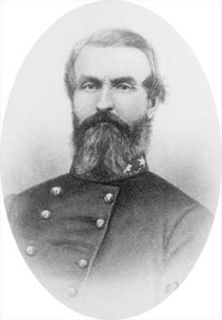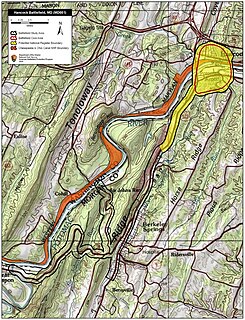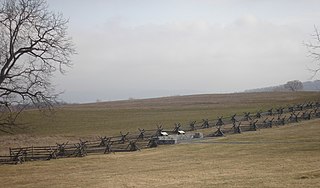
Ambrose Powell Hill Jr. was a Confederate general who was killed in the American Civil War. He is usually referred to as A. P. Hill to differentiate him from another, unrelated Confederate general, Daniel Harvey Hill.

The First Battle of Bull Run, also known as the First Battle of Manassas, was the first major battle of the American Civil War and was a Confederate victory. The battle was fought on July 21, 1861 in Prince William County, Virginia, just north of the city of Manassas and about 25 miles west-southwest of Washington, D.C. The Union's forces were slow in positioning themselves, allowing Confederate reinforcements time to arrive by rail. Each side had about 18,000 poorly trained and poorly led troops in their first battle. It was a Confederate victory, followed by a disorganized retreat of the Union forces.

The Battle of Chantilly took place on September 1, 1862, in Fairfax County, Virginia, as the concluding battle of the Northern Virginia Campaign of the American Civil War. Thomas J. "Stonewall" Jackson's corps of the Army of Northern Virginia attempted to cut off the line of retreat of the Union Army of Virginia following the Second Battle of Bull Run but was attacked by two Union divisions. During the ensuing battle, Union division commanders Isaac Stevens and Philip Kearny were both killed, but the Union attack halted Jackson's advance.

The Appomattox Court House is a National Historical Park of original and reconstructed 19th century buildings in Appomattox County, Virginia. The village is famous as the site of the Battle of Appomattox Court House and containing the house of Wilmer McLean, where the surrender of the Confederate army under Robert E. Lee to Union commander Ulysses S. Grant took place on April 9, 1865, effectively ending the American Civil War. The McLean House was the site of the surrender conference, but the village itself is named for the presence nearby of what is now preserved as the Old Appomattox Court House.

The Battle of South Mountain—known in several early Southern accounts as the Battle of Boonsboro Gap—was fought on September 14, 1862, as part of the Maryland Campaign of the American Civil War. Three pitched battles were fought for possession of three South Mountain passes: Crampton's, Turner's, and Fox's Gaps. Maj. Gen. George B. McClellan, commanding the Union Army of the Potomac, needed to pass through these gaps in his pursuit of Confederate General Robert E. Lee's precariously divided Army of Northern Virginia. Although the delay bought at South Mountain would allow him to reunite his army and forestall defeat in detail, Lee considered termination of the Maryland Campaign at nightfall.

Paul Jones Semmes was a banker, businessman, and a Confederate brigadier general in the American Civil War, mortally wounded at the Battle of Gettysburg.

The Battle of Monocacy was fought on July 9, 1864, approximately 6 miles (9.7 km) from Frederick, Maryland, as part of the Valley Campaigns of 1864 during the American Civil War. Confederate forces under Lt. Gen. Jubal A. Early defeated Union forces under Maj. Gen. Lew Wallace. The battle was part of Early's raid through the Shenandoah Valley and into Maryland in an attempt to divert Union forces away from Gen. Robert E. Lee's army under siege at Petersburg, Virginia. The battle was the northernmost Confederate victory of the war. While the Union troops retreated to Baltimore, Maryland, the Confederates continued toward Washington, D.C., but the battle at Monocacy delayed Early's march for a day, allowing time for Union reinforcements to arrive in the Union capital. The Confederates launched an attack on Washington on July 12 at the Battle of Fort Stevens, but were unsuccessful and retreated to Virginia.

The Battle of Hancock, also called the Romney Campaign, was a battle fought during the Romney Expedition, occurred January 5–6, 1862, in Washington County, Maryland, and Morgan County, West Virginia, as part of Maj. Gen. Thomas J. "Stonewall" Jackson's operations against the Baltimore and Ohio (B&O) Railroad during the American Civil War.

Lafayette McLaws was a United States Army officer and a Confederate general in the American Civil War. He served at Antietam and Fredericksburg, where Robert E. Lee praised his defense of Marye's Heights, and at Gettysburg, where his division made successful assaults through the Peach Orchard and Wheatfield, but was unable to dislodge Union forces from Cemetery Ridge. After the Knoxville Campaign, he was court-martialed for inefficiency, though this was overturned for procedural reasons. Finally he was sent to his native Georgia to resist Sherman's March to the Sea, but had to retreat through the Carolinas, losing many men through desertion, and is presumed to have surrendered with Joseph E. Johnston in April 1865.

Ox Hill Battlefield Park is a site in Fairfax, Virginia, where the Battle of Ox Hill was fought during the American Civil War. It was the only major battle of the war fought in Fairfax County. The battlefield is now a public park adjacent to suburban developments and the Fairfax Towne Center shopping center, and is maintained by the Fairfax County Park Authority.

Antietam National Battlefield is a National Park Service protected area along Antietam Creek in Sharpsburg, Washington County, northwestern Maryland. It commemorates the American Civil War Battle of Antietam that occurred on September 17, 1862.

Stones River National Battlefield, a 570-acre (2.3 km2) park along the Stones River in Rutherford County, Tennessee, three miles (5 km) northwest of Murfreesboro and twenty-eight miles southeast of Nashville, memorializes the Battle of Stones River. This key battle of the American Civil War occurred on December 31, 1862 and January 2, 1863, and resulted in a strategic Union victory.

During the American Civil War (1861–1865), Maryland, a slave state, was one of the border states, straddling the South and North. Despite some popular support for the cause of the Confederate States of America, Maryland would not secede during the Civil War. Because the state bordered the District of Columbia and the strong desire of the opposing factions within the state to sway public opinion towards their respective causes, Maryland played an important role in the war. Newly elected 16th President Abraham Lincoln, suspended the constitutional right of habeas corpus in Maryland; and he dismissed Chief Justice Roger B. Taney of the U.S. Supreme Court's "Ex parte Merryman" decision in 1861 concerning freeing John Merryman, a prominent Southern sympathizer from Baltimore County arrested by the military and held in Fort McHenry. The Chief Justice,, had held that the suspension was unconstitutional and could only be done by Congress and would leave lasting civil and legal scars. The decision was filed in the U.S. Circuit Court for Maryland by Chief Justice Roger Brooke Taney, a Marylander from Frederick and former protege of seventh President Andrew Jackson who had appointed him two decades earlier.
The following outline is provided as an overview of and topical guide to the American Civil War:

The Washington Confederate Cemetery is a Confederate Cemetery in Hagerstown, Maryland. Its burials include Confederate dead from such nearby battles as Antietam, Gettysburg, Monocacy and South Mountain. Less than 20 percent of its burials are identified. It was established in 1871 as a section of the Rose Hill Cemetery (Maryland).
















